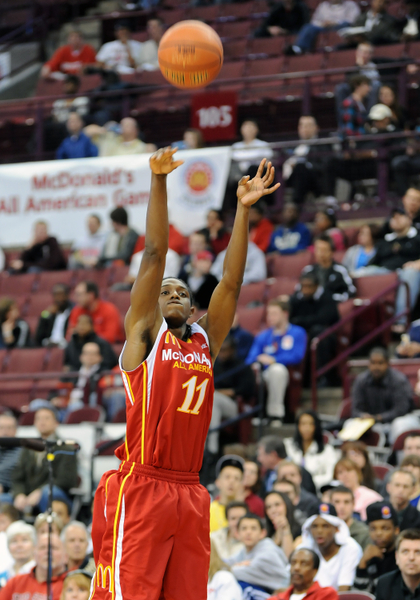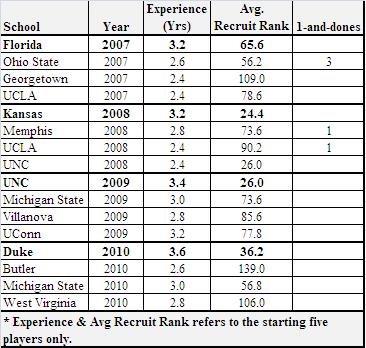In 1-and-Done Era, Experience Wins Championships
Posted by rtmsf on April 16th, 2010(special h/t to Luke Winn for inspiring this analysis with his article here)
You may have heard in recent days that Kentucky’s John Calipari has been filling up on the tasty nougat that has risen to the top of the Class of 2010 high school basketball recruiting lists. Five-star prospect Brandon Knight followed an impressive chorus line of 1-and-done Calipari point guards (D. Rose, T. Evans, J. Wall) by committing to the Wildcats on Wednesday, and Doron Lamb, another five-star combo guard ranked in the top 25, committed today. Turkish stud Enes Kanter committed last week, and there are rumors that others, including versatile top 15 forwards Terrance Jones and CJ Leslie, could be next. All this, and we haven’t even mentioned yet that Michael Gilchrist, the consensus top player in the Class of 2011, has already verballed to go to Kentucky after next season.
The point here is as clear as Ben Roethlisberger’s analgesic salves — high school prospects with dreams of NBA riches a year from now view John Calipari as the pied piper of the NBA Draft. Follow him down the primrose path, and you will end up playing in the League one year later. John Wall, DeMarcus Cousins, Eric Bledsoe and Daniel Orton are the trailblazers here. With all four projected as first rounders in June, the hype of Calipari’s flute-playing squares nicely with reality. And Kentucky’s regal basketball program is the beneficiary.
Or is it?
We’re big believers that there are external benefits to programs who recruit and enroll 1-and-done players beyond wins, losses and NCAA Tournament success. In fact, every year we do exactly such an evaluation that includes criteria beyond that scope. For example, it is our view that the Texas program is still benefitting today from its one year of Kevin Durant on campus in 2007 even though UT only made the second round of the Tournament that season. The same goes with Michael Beasley at Kansas State in 2008. Call it the Jordan Effect. Even if the players who are later inspired to follow Durant and Beasley to those campuses aren’t as good as those two were, there is a significant residual ‘coolness’ effect in recruiting those younger players who can help sustain the quality of the program over time. To put it in terms of Kentucky, a 12-year old right now may spend the next few years idolizing John Wall in the NBA, and when it comes time for him to make his school choice in five years, the Wildcats and Calipari would have already have an inherent advantage over other schools.
With that said, we know what Kentucky fans hope to get from all of these 1-and-done types, and it’s not just a bunch of springtime recruiting victories. Eventually it needs to translate to wins, most specifically those in March and April as Winn alludes to in his article. The question then that we analyze here is whether a focus on recruiting 1-and-doners will get a team to that goal. The available evidence we have, using admittedly a very small sample size, says that it will not.
Take a look at the table below, which lists all sixteen Final Four teams from the 1-and-done era (2007-10).
The first thing to note is that of the sixteen Final Four teams since David Stern enacted the 1-and-done rule for the high school Class of 2006, the rule change hasn’t had much of an impact on the final weekend of college basketball. In fact, of the 32 1-and-doners ( projecting nine in 2010) in the past four seasons, there have only been five such players in the Final Four. Three of them — Greg Oden, Mike Conley and Daequan Cook — were on the same Buckeye team in 2007. The other two — Memphis’ Derrick Rose and UCLA’s Kevin Love — made the final weekend in 2008. There have been none since. It’s not that the list of one-year players isn’t strong; we’ve already mentioned Durant, Beasley, the UK players and can add OJ Mayo, Tyreke Evans, Eric Gordon and many others to the mix, but they generally haven’t been able to carry their teams through to the Four.
The other thing to note is that in each of the Final Fours in the 1-and-done era of college basketball, the most experienced team left standing (we’re talking juniors and seniors) has won the championship. How is this possible? Haven’t we been conditioned to expect that the team with the best talent will win the title, and that the ‘best talent’ is already in the NBA by their junior and senior seasons? Shouldn’t it naturally follow that teams with great young talent should be doing better than this? What we’re seeing here may have been a more reasonable proposition in the years leading up to 2007, when nearly all of the elite talent (in the form of Dwight Howard, Shaun Livingston, Lebron James, etc.) was bypassing college and going straight to the professional ranks. But now? This is admittedly a bit of a surprise.
Yet there’s no mistaking it. Florida started four juniors and a senior. Kansas? — two seniors, two juniors and a sophomore. UNC? — two seniors and three juniors. This year’s Duke team started three seniors and two juniors. There have been no freshman starters of any kind on a championship team since Josh Boone for UConn in 2004, and he became a three-year player. (note: Marvin Williams was a 1-and-doner on the 2005 UNC title team, but he didn’t start for Roy Williams). Don’t get us wrong here. In terms of NBA Draft picks, there was plenty of talent on each of those title teams, but it was experienced talent — talent that for one reason or another had taken a little longer to get to an elite, draftable level. Several lottery picks such as Al Horford and Brandon Rush and Ty Lawson were players for whom the NBA was always on their horizon but because of some perceived or actual deficiency hadn’t been able to put it all together just yet.
And this is where we bring it back to Calipari and Kentucky. The available evidence suggests that Calipari is going to have to figure out a way to keep some of the nasty talent he’s recruiting on campus a little longer than one season so that the players can become familiar enough with each other to push on through to a Final Four and championship. His Memphis team in 2008 was a foul shot away from winning it all, but keep in mind that even that team started a senior and three juniors alongside the wunderkind Rose. This isn’t lost on the coach, who spent much of 2009-10 naysaying how good his team was becuase he knew that they had a tendency to take possessions off, and the only thing that could cure that inefficiency was experience. He’s also gone on record stating that he’d love to have his 1-and-done players for at least two years, with the inference being that when great talent is mixed with a little seasoning and experience, an Elite Eight team can easily become a national champion. It remains to be seen whether Calipari will get his wish with an NBA rule change, but UK fans should take heed of the lessons of this year and the previous three before making Final Four reservations in Houston just yet.















































Nice article. Calipari isn’t a coach. He’s a recruiter, nothing more.
Correction: In 2008, Kansas started Russell Robinson (Senior), Mario Chalmers (Junior), Rush (Junior), Darnell Jackson (Senior), and Darell Arthur (Sophomore). Sherron Collins, my guess for your second sophomore, came off the bench that year.
Thanks, actually we knew that Collins was coming off the bench (see the 3.2 yrs of experience in the table), but somehow made an error on the breakdown in the writeup.
Red, You obviously don’t know much about the game. Calipari takes gonnabee pro players and gets them to play TEAM basketball. That’s coaching! Any coach at a school with the basketball credentials of a Kansas. Syracuse or any big time basketball program can recruit top high school players, but to get them to buy into the TEAM in this era of ‘me, me, me” is great coaching. Not only that, just in case you haven’t noticed these young men are gentlemen and respect not only their coach, but the school programs they play. No Red, you don’t know what good coaching is all about. By the way, look at the progress of many of the players Calipari has coached. That is coaching at it’s best. You obviously don’t understand what it takes to be a great coach in any sport.